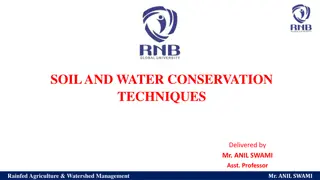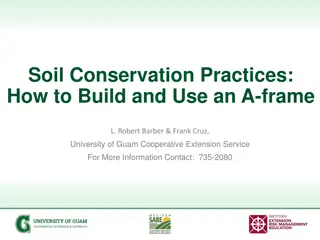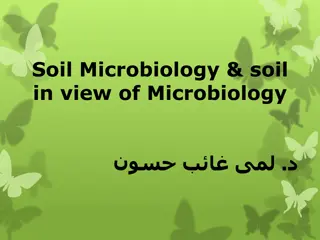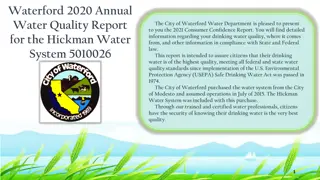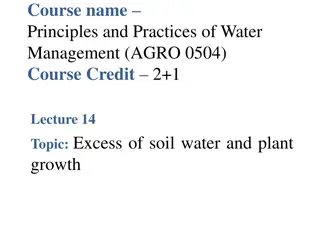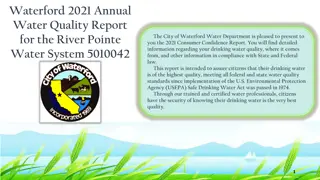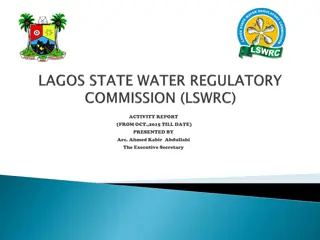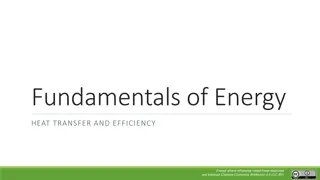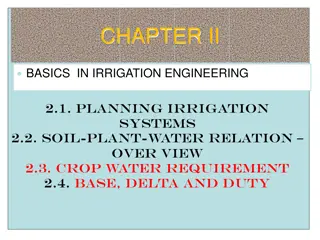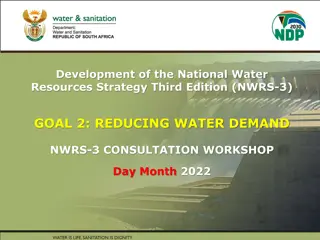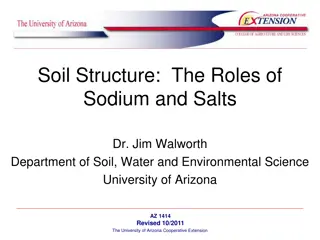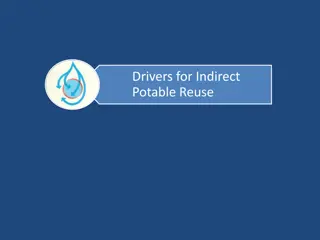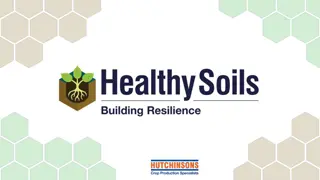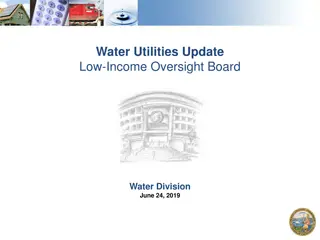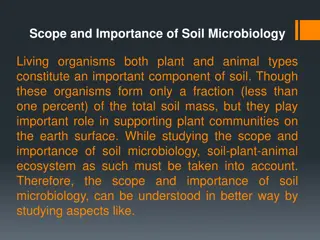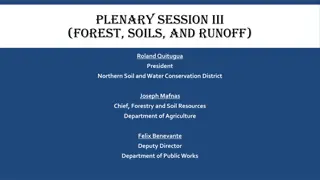NRCS Programs Update
The Inflation Reduction Act (IRA) provides $20 billion to support USDA's conservation programs focusing on climate-related benefits and agricultural resilience. It allocates funds for programs like the Environmental Quality Incentives Program, Agricultural Conservation Easement Program, Regional Con
2 views • 14 slides
Understanding Principles and Practices of Water Management in Agriculture
This course delves into the field water cycle, water movement in soil and plants, soil-plant-water relationships, water dynamics in the soil-plant-atmosphere system, soil composition, soil texture classification, permeability factors, density of soil solids, total porosity assessment, and energy asp
8 views • 62 slides
Understanding Water Management: Principles, Practices, and Soil-Water Relations
Explore the principles and practices of water management in agriculture with a focus on water availability, nutrient relationships, and losses. Discover the physical classification of water, available water defined between field capacity and wilting point, soil water potential, and the soil-plant-at
6 views • 17 slides
Effective Methods for Soil Conservation
Methods to reduce soil erosion and promote soil conservation include terracing, contour planting, strip cropping with cover crops, alley cropping, agroforestry, windbreaks, and conservation tillage practices such as no-till and minimum tillage. These methods help in minimizing soil erosion hotspots
2 views • 11 slides
Soil and Water Conservation Techniques in Rainfed Agriculture by Mr. Anil Swami
Explore soil erosion and various conservation techniques discussed by Mr. Anil Swami, an Assistant Professor specializing in Rainfed Agriculture and Watershed Management. Learn about prevalent soil and climatic conditions in rainfed areas, water harvesting techniques, contingent crop planning, seaso
0 views • 66 slides
Understanding the Importance of Humus in Soil Health
Humus, the organic residue in soil, plays a crucial role in soil fertility and plant growth. It improves soil structure, retains water, stores essential nutrients, and promotes microbial activity. Factors like soil fertility, moisture, temperature, and pH influence the distribution and activity of s
0 views • 21 slides
Soil Conservation Practices: Building an A-Frame for Erosion Control
Learn about the importance of soil conservation practices and how to build and utilize an A-frame tool for erosion control. Discover the causes of soil erosion and effective techniques like contour lines, contour planting, and vegetative barriers to prevent soil degradation. Find out how to construc
2 views • 14 slides
Understanding Soil Microbiology and Its Impact on Plant Growth
Soil microbiology is a branch of science that focuses on studying soil microorganisms and their activities, which play a crucial role in supporting plant life. Soil consists of organic and inorganic matter, water, and living organisms that interact in complex ways to influence plant growth and nutri
1 views • 11 slides
Soil Disinfestation Methods for Greenhouse Crop Production
Soil mixes for greenhouse production are carefully designed to optimize water retention and aeration. Proper management of artificial soil mixes can yield crops equal to those grown in topsoil. Sterilization of growing media is crucial, with techniques such as steam sterilization and fumigation comm
0 views • 11 slides
Understanding Soil Chemistry and Redox Reactions in Environmental Chemistry
Soil chemistry plays a crucial role in sustaining healthy soils by influencing nutrient availability through oxidation and reduction processes. Redox reactions in soil are impacted by factors like oxygen content and water presence, affecting nutrient supplies. The redox status of soil reflects its n
1 views • 92 slides
Understanding the Diversity of Microorganisms in Soil Ecosystems
Microorganisms in soil play crucial roles in soil fertility, nutrient cycling, and industrial product synthesis. They can also be pathogens causing diseases in plants and humans. Soil organisms are broadly classified into two groups: soil flora and soil fauna, consisting of various microorganisms li
0 views • 57 slides
The Global Water Crisis and Transboundary Issues in Southern Africa
The global water crisis is a pressing issue affecting millions worldwide, with about 700 million people currently living below the water-stress threshold. By 2025, this number is projected to reach 3 billion. The increasing pressure on shared water resources in countries like Botswana, Namibia, and
0 views • 52 slides
Waterford 2020 Annual Water Quality Report for Hickman Water System
Waterford's 2020 Annual Water Quality Report provides detailed information on the Hickman Water System, assuring citizens of highest quality drinking water that meets federal and state standards. The report includes water conservation tips and highlights the city's commitment to water quality and co
0 views • 11 slides
Understanding Soil Composition and Importance
Explore the world of soil and its significance as a natural resource by discovering its composition and how it affects plant growth. Learn about the main ingredients of soil, its permeability, and the role of water, air, and organic matter. Gain insights into how soil supports plant life through lea
1 views • 30 slides
Understanding Excess Soil Water and Plant Growth in Water Management
Excess soil water can lead to waterlogging, affecting plant growth negatively by creating anaerobic conditions, promoting growth of water-loving plants, hindering tillage operations, accumulating harmful salts, lowering soil temperature, and reducing crop maturity time. Preventive measures include c
0 views • 8 slides
Waterford 2021 Annual Water Quality Report Overview
The Waterford 2021 Annual Water Quality Report provides detailed information on the River Pointe Water System, assuring citizens of the highest drinking water quality standards met since the implementation of the Safe Drinking Water Act. The report covers water source, quality details, conservation
1 views • 11 slides
Overview of Lagos State Water Regulatory Commission's Activities Since 2015
The Lagos State Water Regulatory Commission (LSWRC) was established in 2012 to oversee water supply and wastewater management services in Lagos State. Since 2015, under the leadership of Executive Secretary Arc. Ahmed Kabir Abdullahi, the commission has focused on promoting sustainable services, att
0 views • 14 slides
Understanding Energy Efficiency and Conservation Fundamentals
This unit introduces basic terms related to energy, efficiency, and conservation, covering topics such as Efficiency and Conservation Energy, First and Second Law of Thermodynamics, and various heat transfer mechanisms. It emphasizes responsible energy use, focusing on efficiency, conservation, and
0 views • 14 slides
Water Conservation Strategies at Sardar Patel Institute of Technology
Explore the comprehensive water conservation initiatives undertaken by the students of Sardar Patel Institute of Technology. Learn about the importance of water conservation, typical household water usage, and practical tips to reduce water consumption. Discover ways to conserve water through method
0 views • 39 slides
Basics of Crop Water Requirements in Irrigation Engineering
Understanding crop water requirements is crucial in planning effective irrigation systems. Crop water requirements are determined by factors such as evapotranspiration, soil conditions, and achieving maximum production potential. Effective rainfall, soil moisture storage, and groundwater contributio
0 views • 83 slides
Enhancing Water Conservation and Demand Management in South Africa
The National Water Resources Strategy Third Edition (NWRS-3) focuses on reducing water demand in South Africa by implementing effective water conservation and demand management measures across various sectors. Challenges include inadequate planning, lack of funding, and weak enforcement tools. Secto
1 views • 20 slides
Understanding Soil Erosion and Conservation in 6th Grade Science
Soil erosion is the process of soil wearing away, commonly caused by natural forces like wind, water, gravity, and ice, as well as human activities such as farming, mining, and construction. Severe weather events can accelerate soil erosion. Soil conservation techniques like crop rotation, conservat
0 views • 12 slides
Soil Chemistry and Mineralogy Analysis at CSU Summer Soil Institute
Explore the comprehensive analysis of soil chemistry, texture, and mineralogy conducted at the CSU Summer Soil Institute in July 2010. The study delves into pedology, elemental composition, particle size distribution, X-ray diffractometry, and mineralogical composition of various soil samples. Detai
0 views • 22 slides
Understanding Water Potential in Plant Physiology
Water potential is a crucial concept in plant physiology, driving the movement of water within plants. It is a measure of potential energy in water and influences processes like photosynthesis. This potential is influenced by factors such as solute concentration, pressure, gravity, and matrix effect
0 views • 25 slides
Understanding Soil Characteristics and Ecosystem Interactions
This content explores various aspects of soil characteristics, including factors influencing soil thickness, the role of bedrock in soil quality, optimal soil mixtures for plant growth, the impact of living organisms on weathering, and the formation of soil. It also discusses how animals can help so
0 views • 17 slides
Understanding Soil: Formation, Composition, and Impact on Plant Growth
Soil is more than just dirt; it plays a vital role in supporting plant growth. Formed through the weathering of rocks and organic activity, soil consists of rock fragments, clay, and organic material. The process of soil formation begins with the erosion of bedrock, leading to the development of dif
0 views • 12 slides
Exploring the Fascinating World of Soil: An Insightful Journey
Delve into the intricate composition of soil through a hand lens to uncover rocks, minerals, and humus. Discover the hidden elements like water, air, and living organisms that form the foundation of soil. Witness the decomposition process by bacteria and fungi, and explore the layers of a soil profi
0 views • 15 slides
Impacts of Prescribed Burning on Soil Fertility in Mediterranean Pastures
This study investigates the effects of prescribed burning on soil fertility and carbon dynamics in Mediterranean mountain pastures. It explores how soil responds to disturbance by prescribed burning, potential legacy effects based on pre-burning conditions, and the role of local microtopography in s
0 views • 8 slides
Understanding the Role of Sodium and Salts in Soil Structure
Soil structure plays a crucial role in plant growth, water movement, and drainage. Excess sodium can cause clay particles to disperse, leading to reduced water infiltration. Flocculation, which involves cations like calcium and magnesium, helps clay particles stick together to form aggregates, impro
0 views • 29 slides
Understanding Factors of Soil Formation and Soil Geography
Soil formation is a complex process influenced by factors like weathering, organic matter, and minerals. Soil geography studies soil distribution using geographic methods and cartography. Various definitions of soil highlight its importance for plant growth and as a natural body with distinct horizo
0 views • 20 slides
Understanding Conservation and Taking Action
Explore the purpose of conservation and learn how to plan and execute conservation projects using local, regional, and national resources. Discover the legacy of the ArrowCorps service project and understand the difference between conservation and preservation. Identify conservation issues and resou
0 views • 12 slides
Conservation Challenges and Opportunities in the 2018 Farm Bill
The 2018 Farm Bill presents a battleground where conservation, environmental protection, and agricultural interests collide. Key issues include changes in the Clean Water Act, pesticide use, CAFO operations, NEPA requirements, and potential impacts on conservation programs like the Conservation Stew
0 views • 7 slides
Strategies for Sustainable Water Management
Drivers for indirect potable reuse include water stress, population growth, industrial development, droughts, and climate change. Other drivers for water reuse encompass conservation, environmental enhancement, pollution abatement, and regulatory policies. Rising water rates and costs of imported wa
0 views • 21 slides
Understanding Soil Health for Sustainable Ecosystems
Soil health, defined as the capacity of soil to function as a living ecosystem supporting plants, animals, and humans, is crucial for sustaining life. This content explores the imperatives, opportunities, and key practices such as no-till and cover crops to enhance soil health. It also delves into d
0 views • 33 slides
Microbial Transformations of Nitrogen in Soil: Factors, Forms, and Impact on Plant Nutrition
Understanding the microbial transformations of nitrogen in soil is crucial for optimizing plant nutrition. Factors such as climate, water supply, cultivation, soil texture, and depth influence the nitrogen content in soil. The different forms of soil nitrogen, including inorganic and organic compoun
0 views • 23 slides
Understanding the Role of Soil Biology in Lawn Care
Soil biology plays a crucial role in maintaining healthy and vibrant lawns. Various organisms, including invertebrates, plant roots, mycorrhizae, and micro-organisms, contribute to functions such as soil structure maintenance, regulation of soil hydrological processes, gas exchange, carbon sequestra
0 views • 27 slides
Importance of Describing Soil Profiles for Soil Suitability Analysis
Proper classification and interpretation of soil properties through describing soil profiles are essential in determining soil suitability for various uses. Soil classification involves describing, classifying, and interpreting soil properties to understand the best uses and limitations of the soil.
0 views • 5 slides
Water Utilities Update - Low-Income Oversight Board Summary
Water Utilities Update Low-Income Oversight Board on June 24, 2019 discussed topics such as low-income OIR workshop, school lead testing, conservation, proposed legislation, acquisitions, and human right to water. The workshop focused on water rate design for a basic amount of water at a low quantit
0 views • 9 slides
Understanding the Scope and Importance of Soil Microbiology in Ecosystems
Soil microbiology plays a significant role in supporting plant communities and maintaining soil health. Living organisms, both plant and animal types, form only a small fraction of soil mass but are crucial for processes like plant growth, organic matter decomposition, humus formation, and biogeoche
0 views • 14 slides
Plenary Session III on Forest, Soils, and Runoff Featuring Key Speakers
The Plenary Session III on Forest, Soils, and Runoff showcased insights from prominent figures such as Roland Quitugua, President of the Northern Soil and Water Conservation District, Joseph Mafnas, Chief of Forestry and Soil Resources at the Department of Agriculture, and Felix Benevante, Deputy Di
0 views • 4 slides




